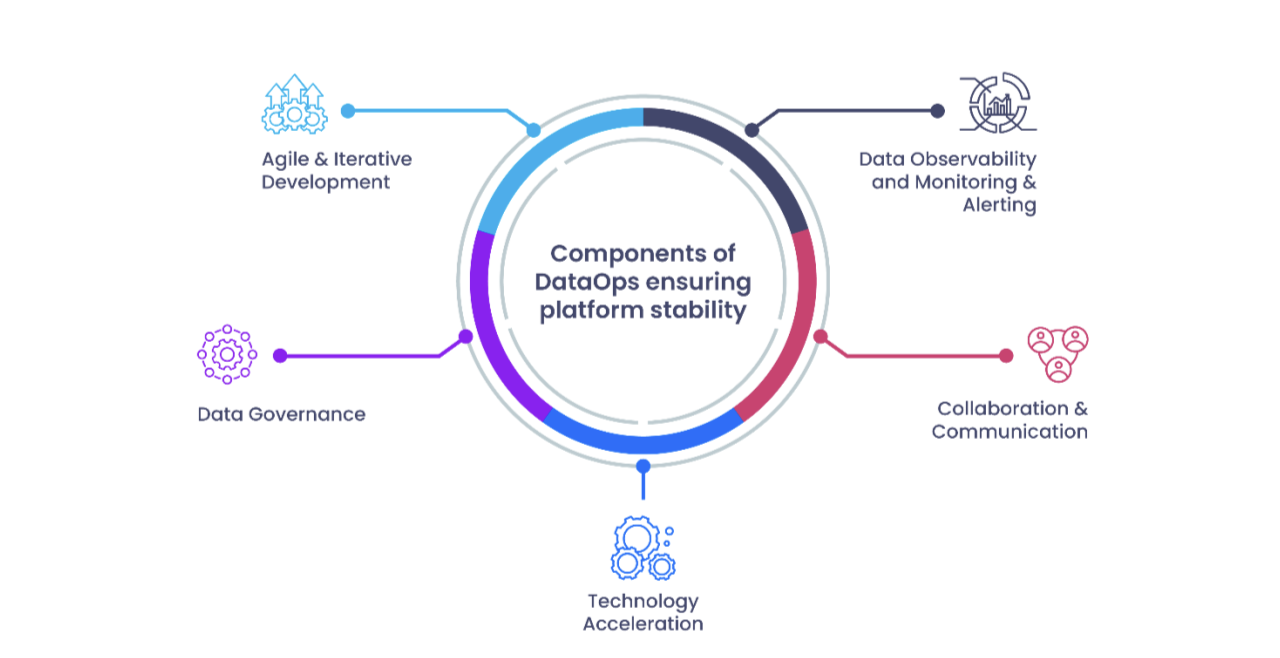
Listen to this blog
With the rapid growth and transformation in technology that the modern world is experiencing, every second enormous amounts of data are generated for both professional and personal purposes. We check our emails, enter passcodes to unlock our devices or make a simple phone call, and in these everyday routine actions, significant volumes of data are transmitted. When shifting to the business side, data is vital for the day-to-day operations for all kinds of businesses. For instance, for effective warehouse management, organizations generate large amounts of data from various inventory systems, and leverage it to optimize storage layouts, plan effective strategies for product placement, and improve their order accuracy.
The exponential growth in data, along with rapid advancements in technology and constantly evolving analytical needs, have made it crucial for organizations to adopt efficient ways for managing data platforms. Not only this, but many organizations are also suffering from collaboration bottlenecks, operational inefficiencies, data quality and reliability issues, and complex data integration processes. These issues have made it imperative to reduce the time-to-market, achieve higher levels of productivity, and increase data quality and reliability across the organization.
As organizations strive to achieve stability in data operations, they struggle to simultaneously prioritize other strategic business objectives such as new feature enablement and end-user experience enhancement. DataOps has emerged as a transformative solution to support data platform stability. An automated and process-oriented approach to DataOps reduces the manual effort and time it takes to support data operations and instead allows stakeholders to focus on more strategic outcomes such as product innovation, new feature enablement, customer satisfaction, and user experience.
In this blog we will explore the pivotal role that DataOps plays in ensuring operational stability of data platforms.
Key DataOps Components to Ensure Data Platform Stability

![]()
1. Agile and Iterative Development:
One of the main components of DataOps is agile and iterative development which focuses on breaking down tasks into smaller chunks, enabling teams to work iteratively and progress quickly by easily adapting to change. This component places a high emphasis on frequent feedback flowing back & forth within the organization and ensures that gradual updates are made to the data platform based on that feedback. Such smaller and recurring updates promote a culture of continuous improvement & continuous development and enable organizations to continuously enhance and refine their data operations, systems, and processes.
Agile and iterative development enables DataOps teams to identify and address any problems pertaining to instability or suboptimal performance of data platforms, rectify them quickly, and ensure a more reliable and robust data platform.
2. Data Observability and Monitoring and Alerting Mechanisms:
Another fundamental principle of DataOps is data observability, which, when combined with monitoring and alerting mechanisms ensures stability across the data platform. Data observability provides end-to-end visibility of data pipelines and facilitates visualization of the data flow at a granular level, to track all data pipelines from ingestion to consumption. Monitoring & alerting mechanisms enable the identification of issues across these pipelines and generate alerts for their timely resolution. In this way data observability along with monitoring & alerting, provides increased transparency and facilitates uninterrupted data flow.
3. Data Governance:
Data governance supports efficient data management by establishing clear guidelines and precise data standards. By clearly defining and implementing these standards, organizations ensure that high quality data is available for use by business users. To ensure smooth operations for data platforms, several key aspects of data governance are essential:
- Data quality: Focuses on ensuring that the data is complete, consistent, accurate, and reliable
- Data freshness: Monitors how frequently data is updated and refreshed, sending alerts to stakeholders in case of any delays
- Change management: Ensures that updates to systems, processes & configurations within a data platform are controlled and organized, preventing unplanned disruptions
- Incident management: Enables the prompt identification, analysis, and resolution of any data-related incidents
- Data health checks: Proactive identification and mitigation of data anomalies before they become critical and negatively impact the data platform
Altogether, these components ensure effortless data governance and reliable operations throughout the organization.
4. Collaboration & Communication:
DataOps promotes a culture of collaboration between various teams in an organization, making cross-departmental communication one of its core components. This focuses on breaking down team silos so that stakeholders across departments such as data scientists, engineers, developers, and business analysts collaborate closely. It also helps them identify and resolve issues promptly and with minimum delays. This increased collaboration and effective communication result in cross-functional expertise, where diverse perspectives from various departments contribute to top-notch ideas and well-versed solutions. This also results in greater transparency between the teams which in turn leads to improved operational efficiency.
5. Technology Acceleration:
Another vital component of DataOps is technology acceleration which promotes a culture for organizations to stay up to date with modern tools, and actively integrate them into DataOps practices wherever possible to carry out everyday business operations. The adoption and implementation of the latest tools & technologies plays a vital role in ensuring platform stability through automation Automating data processes such as ingestion, transformation, and deployment reduces the risk of human errors, increases efficiency, and ensures smooth data operations.
As automation replaces manual processes, technology acceleration contributes to better workload and platform management, thus enhancing platform stability. It additionally aids in cost and performance optimization and also facilitates scalable data operations for managing large volumes of data. Moreover, technology acceleration promotes platform compliance by aligning data operations and processes with industry best practices and regulations. Embracing such technology-driven initiatives fosters a reliable and steady modern data platform that supports business objectives and facilitates seamless data operations across the organization.
Visionet’s DataOps Services
At its core, Visionet is committed to empowering organizations with faster speed-to-market for new feature enablement and minimized data downtime. By leveraging DataOps and its best principles, we automate processes, enabling organizations to prioritize strategic goals and deliver exceptional end user experiences. Our expertise with DataOps can help stabilize technology and strengthen governance by establishing efficient data management practices. Through continuous improvement and enhanced collaboration, we aim to elevate productivity levels, optimize performance and reduce costs- all while ensuring a robust data platform for you.
Unlock your data platform's true potential with Visionet. Take the next step for streamlined operations and accelerated growth today!




